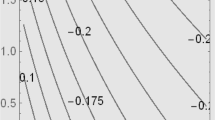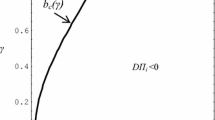Abstract
Existing theoretical literature fails to explain satisfactorily the differences between the pay of workers who are covered by collective agreements and others who are not. This study aims at providing a model framework that is amenable to an analysis of this issue. Our general-equilibrium approach integrates a dual labor market and a two-sector product market. The results suggest that the so-called “union wage gap” is largely determined by the degree of centralization of the bargains and, to a somewhat lesser extent, by the expenditure share of the unionized sector's goods.

Similar content being viewed by others
Notes
For a more general formulation, see Blanchard and Giavazzi (2003, p. 881).
If workers were distributed unevenly, some of them could increase the probability of an employment by reallocating themselves to a firm where less workers are attached.
Since all agents fare better in the case of an agreement, this second term serves only as the “conflict point” during the bargain, but is never realized.
As noted earlier, wages, demand, labor input, and so forth are the same for all firms in a symmetric equilibrium. Nevertheless, the bargaining parties consider these variables to depend on the result of the bargain if they are related to them, and as exogenous if they are related to other firms/workers.
Unfortunately, the definition and measurement of bargaining coverage are not unambiguous. One difference between the reported coverage rates is that some of them adjust for the fact that, in several countries, not all workers have the legal right to bargain. From the role of the parameter in the model, it is clear that we must take the unadjusted coverage rate. Therefore, the OECD data were only viable for those countries where all workers have the right to bargain, so that both rates coincide. For instance, this is the case in Italy.
The 1994 value has to be taken from 1993, which is the last one published.
To avoid computational problems, a value of 0.0001 rather than literally zero is the minimum (employed for USA and Canada).
This source converts the national data such that they approximate US concepts. The Danish values stem from OECD (2001, p. 20f).
These values are comparable with those of Elbehri and Hertel (1999).
I would like to thank one anonymous referee for making this point.
References
Antweiler W, Trefler D (2002) Increasing returns and all that: a view from trade. Am Econ Rev 92(1):93–119
Bertrand M, Kramarz F (2002) Does entry regulation hinder job creation? evidence from the French retail industry. Q J Econ 117(4):1369–1413
Blanchard OJ, Giavazzi F (2003) Macroeconomic effects of regulation and deregulation in goods and labor markets. Q J Econ 118(3):879–908
Blanchflower DG (1996) The role and influence of trade unions in the OECD. Discussion Paper 310. Centre for Economic Performance, London, UK
Blanchflower DG (1999) Changes over time in union relative wage effects in Great Britain and the United States. In: Daniel S, Arestis P, Grahl J (eds) The history and practice of economics: essays in honour of Bernard Corry and Maurice Peston. Edward Elgar, Cheltenham, pp 3–32
Blanchflower DG, Bryson A (2003) Changes over time in union relative wage effects in the UK and the US revisited. Working Paper 9395. NBER, Cambridge, MA
Blanchflower DG, Bryson A (2004) What effects do unions have on wages now and would ‘what do unions do?’ be surprised? J Labor Res 25(3):383–414
Blanchflower DG, Freeman RB (1992) Unionism in the US and other advanced OECD countries. In: Bognanno M, Kleiner M (eds) Labor market institutions and the future role of unions. Blackwell, Oxford, pp 56–79
Boeri T, Nicoletti G, Scarpetta S (2000) Regulation and labour market performance. In: Galli G, Pelkmans J (eds) Regulatory reform and competitiveness in Europe. Edward Elgar, Cheltenham, pp 324–380
Boeri T, Brugiavini A, Calmfors L (eds) (2001) The role of unions in the twenty-first century. Oxford University Press, Oxford
Booth AL, Bryan ML (2004) The union membership wage–premium puzzle: is there a free rider problem? Ind Labor Relat Rev 57(3):402–421
Bratsberg B, Ragan JF (2002) Changes in the union wage premium by industry—data and analysis. Ind Labor Relat Rev 56(1):65–83
Calmfors L, Driffill EJ (1988) Bargaining structure, corporatism and macroeconomic performance. Econ Policy 3(1):13–47
Elbehri A, Hertel TW (1999) Economic integration, market structure and growth dynamics. Paper presented at the Second Annual Conference on Global Economic Analysis, Denmark
Freeman RB, Medoff JL (1984) What do unions do? Basic Books, New York
Hirsch BT (2004) Reconsidering union wage effects: surveying new evidence on an old topic. J Labor Res 25(2):233–266
Hirsch BT, Schumacher EJ (2004) Match bias in wage gap estimates due to earnings imputation. J Labor Econ 22(3):689–722
Iversen T (1998) Wage bargaining, central bank independence, and the real effects of money. Int Organ 52(3):469–504
Jean S, Nicoletti G (2002) Product market regulation and wage premia in Europe and North America: an empirical investigation. Working Paper 318. OECD Economics Department, Paris, France
Kenworthy L (2003) Quantitative indicators of corporatism. Int J Sociol 33(3):10–44
Nickell SJ (1999) Product markets and labour markets. Labour Econ 6(1):1–20
Nicoletti G, Bassanini A, Ernst E, Jean S, Santiago P, Swaim P (2001) Product and labour markets interactions in OECD countries. Working Paper 312. OECD Economics Department, Paris, France
OECD (1997) OECD employment outlook. OECD, Paris
OECD (2001) Labor force statistics: 1980–2000. OECD, Paris
Oliveira Martins J, Scarpetta S, Pilat D (1996) Mark-up rations in manufacturing industries: estimates for 14 OECD countries. Working Paper 162. OECD Economics Department, Paris, France
Robinson C (1989) The joint determination of union status and union wage effects: some tests of alternative models. J Polit Econ 97(3):639–667
Roeger W (1995) Can imperfect competition explain the difference between primal and dual productivity measures? Estimates for US manufacturing. J Polit Econ 103(2):316–330
Saint-Paul G (1996) Dual labor markets: a macroeconomic perspective. MIT Press, Cambridge, MA
Soskice D (1990) Wage determination: the changing role of institutions in advanced industrialized countries. Oxf Rev Econ Policy 6(4):36–61
Traxler F (1996) Collective bargaining and industrial change: a case of disorganization? A comparative analysis of eighteen OECD countries. Eur Sociol Rev 12(3):271–287
US Department of Labor (2002) Comparative civilian labor force statistics: ten countries, 1959–2001. http://www.bls.gov/fls/flsforc.pdf
Visser J (2003) Unions and unionism around the world. In: Addison JT, Schnabel C (eds) The international handbook of trade unions. Edward Elgar, Cheltenham, pp 366–413
Acknowledgements
The first draft of this paper has been prepared during a visit to the Universitá degli Studi di Modena e Reggio Emilia. I thank the entire Economics Department (in particular Graziella Bertocchi, Marina Murat, and Sergio Paba) for the hospitality I received. I would also like to thank Christian Dustmann, Chiara Strozzi, and two anonymous referees for their comments.
Author information
Authors and Affiliations
Corresponding author
Additional information
Communicated by Christian Dustmann.
Rights and permissions
About this article
Cite this article
Sanner, H. Imperfect goods and labor markets, and the union wage gap. J Popul Econ 19, 119–136 (2006). https://doi.org/10.1007/s00148-005-0010-6
Received:
Accepted:
Published:
Issue Date:
DOI: https://doi.org/10.1007/s00148-005-0010-6




